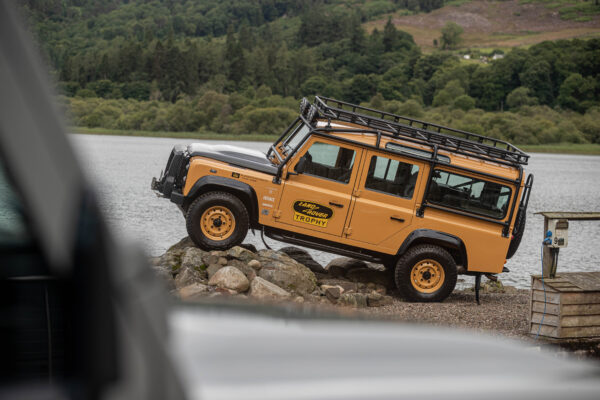A Revived Legend: The Land Rover Classic Defender Works V8
The world's most iconic four-by-fours are now made to measure.

T here was a time, not so long ago, when altering a classic car using more modern parts and accessories would have been considered sacrilege. Indeed, the classic car world has traditionally valued authenticity above all else. At the world’s most prestigious classic car competitions, such as the Pebble Beach Concours d’Elegance, judges obsess over vehicle codes and supporting documentation to ensure that the award-winners are as original as when they were first manufactured. But over the past few years, a new movement has emerged that blends classic car nostalgia with modern technology. And while these “classics” may not win a prize at Pebble Beach, they represent a more practical way to keep such motoring legends powering right along.
Case in point, a factory-blessed reimagining of the iconic Land Rover Defender.

The direct descendant of the original Land Rovers—the Series I (which debuted over 75 years ago) through Series III—the Defender first appeared on the world stage in 1983, originally named the 90, 110, and 130 according to the three available wheelbase lengths. The Defender name (as an umbrella term) has been used formally since 1991. And while this first production run of Defenders concluded in 2016, a recently launched factory restoration program gives these vehicles a second life.
The Jaguar Land Rover Classic Works facility opened in Coventry, England, in June 2017. Reportedly the largest restoration house in the world, the 150,000-square-foot space can house some 500 project vehicles at a time. Within its walls, technicians work on factory-restored classics (the kind that could win at Pebble Beach) and so-called continuation models such as the Jaguar D Type Continuation (list price: £1.25 million). They’ve also identified an era of Defender that’s perfectly suited to certain modifications.
The Defender in question was produced from 2012-16. Originally powered by a 2.2-litre four-cylinder diesel, its engine compartment is large enough to house a 5.0-litre V8 gas engine. The idea of swapping engines was one of the inspirations behind the factory-stamped restomod, dubbed the Classic Defender Works V8. The V8 generates a healthy 405 horsepower and 380 lb-ft of torque, far more than the original four-cylinder, but big numbers are just a small part of the overall picture. From a mechanical standpoint, the Classic Defender Works V8 also features a new eight-speed automatic transmission, braking system, and suspension components. “We’re sort of limited by the vehicle itself with what you can and can’t change,” says Steven Grant, lead bespoke engineer for Jaguar Land Rover Classic. “Although it still feels like a Defender and behaves like a Defender, it has got bigger brakes that are limited by wheel size. There are heavy-duty differentials, torque-biasing centre differentials. Everything has been reworked and improved.”


Of course, the vehicles also receive a complete cosmetic restoration top to bottom. As with other manufacturers that offer such services, there’s really no limit to the special requests that can be met. Given that this series of Defender is not all-original and never will be, this perhaps engenders an even greater sense of freedom among potential customers. Step one is to go online to the Land Rover Classic Works site and see if the mad scientists there have already built something to your liking. The initial run of Classic Defender Works V8 vehicles was almost a proof-of-concept exercise. Four different vehicles were created to show the world what could be done and to fire the imagination of prospective customers.

For the moment, two of the four models are sold out, but two are still available: the Classic Defender Works V8 Islay Edition and the Classic Works Trophy II. The former is the most retro of the Classic Defender Works V8s. The name comes from the isle of Islay, one of the Inner Hebrides off the west coast of Scotland. (This is where Spencer Wilks, one of the founders of the Land Rover brand, drove the Series IIa back in 1965.)
There will be just 30 examples of the Islay Edition built over the entire production run—17 of the short-wheelbase 90 and 13 of the long-wheelbase, seven-seat 110. Featuring a Heritage Grey paint scheme with a white roof and Limestone-coloured steel wheels, it definitely looks distinguished for its age. Meanwhile, the Classic Works Trophy II is a Defender 110 that resembles the vehicles from the old Camel Trophy adventure competitions. Limited to 25 examples, the Trophy II is available as a short-wheelbase 90 or a double-cab pickup truck body style. If none of the existing Classic Defender Works V8s suits your tastes, there’s another avenue: simply fire up the Land Rover Classic online configurator tool and build your own bespoke model. You start by choosing a wheelbase and body style, then select an exterior paint scheme from a catalogue of options or give the Works team your favourite shade to match. From there, you can choose from among three front grille styles, two wheel packages, and an exterior trim package in silver or black. The list of exterior accessory options is extensive, including a roof rack, expedition cage, ladder, winch, roof-mounted spotlights, and side steps.

If you’re a fan of the original Defender, the sky is the limit. You can find them on farms all over western Europe and import them in as-is condition. You can also find some in top restoration shops such as the creative geniuses at Osprey Custom Cars in Castle Hayne, North Carolina, where old Defenders are revitalized using nonfactory parts and accessories—and the results are wildly impressive. Or you can have the experts who originally manufactured the Defender take on your project. The only decision left is whether to restore this classic to like-new or better-than-new condition.




